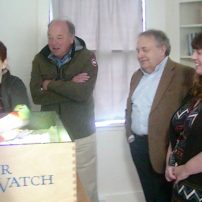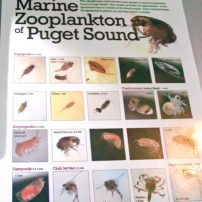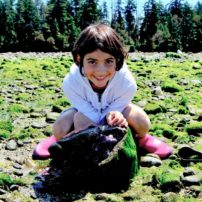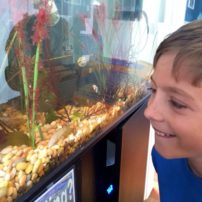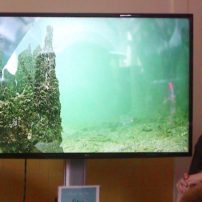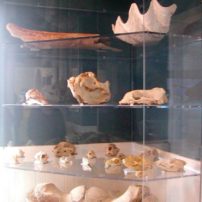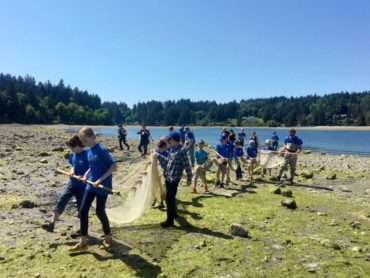
Consider this: The Kitsap Peninsula has more than 370 miles of coastline with some of the most magnificent marine environments on the planet. That’s a lot of territory to learn about and explore.
Harbor WildWatch makes it its mission to introduce people of all ages to the wonders of Puget Sound.
Based in Gig Harbor, the nonprofit organization was founded in 2004 and began its community outreach efforts with a few “touch tank” events at the city pier. The touch tanks gave people a chance to see and touch moon snails, sea cucumbers, nudibranchs, sea stars and other near-shore creatures found in Puget Sound. Volunteers were on hand to answer questions and talk about being good stewards of the environment.
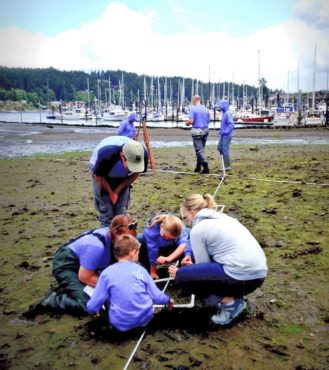
As community support grew — and grow it did — more programs about local marine life were added to WildWatch’s repertoire. The programs included guided beach walks, salmon tours, wetland tours and the popular “Pier into the Night” events that take place during the dark winter months.
By 2009, it was apparent that young people were increasingly interested in learning more about the local marine environment, so WildWatch developed a series of “classroom science” workshops and a junior-naturalist training program.
More expansion came in 2013, including the debut of the “citizen science” training program, college internships and more opportunities for disadvantaged youth.
Another big step occurred in the summer 2014, when Harbor WildWatch entered into an agreement with the city of Gig Harbor to use the historic Skansie House on the downtown waterfront as a marine interpretive center. In the first year, more than 10,000 people had visited the center.
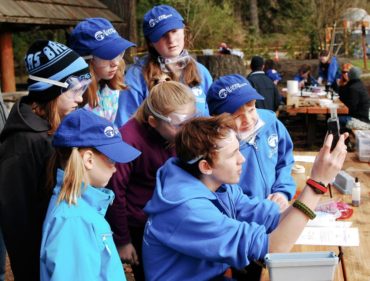
This March, the organization unveiled a number of new exhibits at the center, thanks to a $25,000 grant from the Ben B. Cheney Foundation.
There’s a new, permanent touch tank; an underwater camera; new microscopes; a large display case for WildWatch’s collection of bird and animal skulls and a high-tech, interactive sandbox.
Among other underwater critters, the new touch tank contains several varieties of sea stars including a mottled star, an ochre star and an unusual leather star. There’s also a sea cucumber, a frosted nudibranch (a shell-less marine mollusk also called a sea slug) and several other “touchables.”
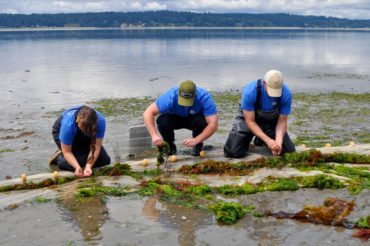
A separate tank within the touch tank is home to a collection of anemones and feather duster tube worms, and serves as a “time out” place for any touch tank critters that need a break from human handling, according to Development Associate Jennifer Beard.
“If any of the touchable critters show signs of stress and need a timeout, we can transfer them right into the separate big tank. That way, they’re still visible but they’re in a hands-off area,” Beard said.
Next to the touch tank, a video screen shows images transmitted from the new, wireless, underwater camera installed on an old, barnacle-crusted piling at the nearby Skansie Netshed.
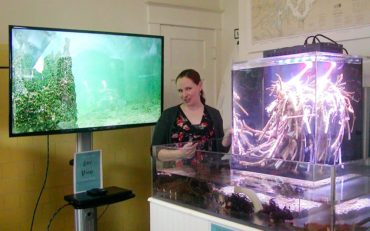 The camera sends real-time images to the indoor screen so visitors can watch barnacles feeding as the tide comes in, see crabs scurrying along the sand and whatever else might be swimming or crawling around in the bay. Eventually, HWW hopes to build an artificial reef near the camera location to lure even more sea life into view.
The camera sends real-time images to the indoor screen so visitors can watch barnacles feeding as the tide comes in, see crabs scurrying along the sand and whatever else might be swimming or crawling around in the bay. Eventually, HWW hopes to build an artificial reef near the camera location to lure even more sea life into view.
The new microscopes help visitors discover the amazing assortment of life that exists in a single drop of seawater or observe how a tiny bit of plankton works. The microscope slides plug into a video screen so a group of people can observe what’s under the scope.
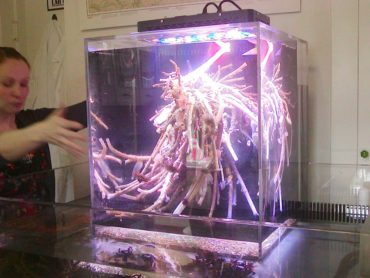 A new dissecting microscope gives an up-close and personal view of a sliver of baleen or piece of squid or other materials, Beard added.
A new dissecting microscope gives an up-close and personal view of a sliver of baleen or piece of squid or other materials, Beard added.
Squid dissection is an especially popular activity. “We use California market squid — like you can buy in a grocery store,” she said. “It’s a really good way to learn about anatomy and how living things work.”
The microscopes are “almost bullet-proof,” according to Beard.
“They’re very intuitive and the directions are very easy to follow,” she said. “They’ll be put to good use in our citizen science programs.”
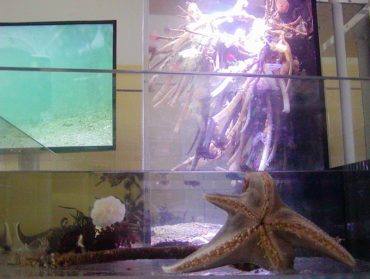 In a sunny corner near the microscope table, the new display case shows off Harbor WildWatch’s impressive collection of skulls, including the huge skull of a juvenile gray whale, a recent gift from the National Oceanic and Atmospheric Administration.
In a sunny corner near the microscope table, the new display case shows off Harbor WildWatch’s impressive collection of skulls, including the huge skull of a juvenile gray whale, a recent gift from the National Oceanic and Atmospheric Administration.
At last count, there were 18 skulls of local birds and animals, plus a petrified mastodon femur, a giant clamshell and a large piece of coral.
“We often take some of the skulls to public events,” Beard said. “People really like to try to identify them.”
The highlight of the new exhibits is the augmented reality sandbox. “This isn’t your kid’s backyard sandbox,” Education Director Rachael Easton said with a smile. “The sand is real, but as you move the sand around with your hands, the amazing technology shows how the topography changes and how the water moves around.
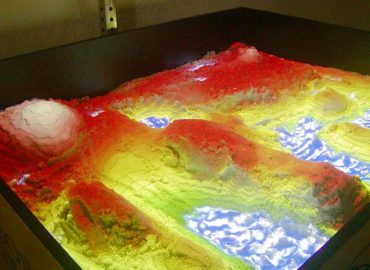
“You can dig rivers or bays or lakes, or pile the sand into hills or mountains. And you can even make it rain virtual rain or snow and watch how the water moves around in the landscape.”
And that’s not all. Push a button and a volcano erupts, Easton said. Push another button and a virtual tsunami is created.
The idea is to educate people about the local watershed, and volunteers are on hand to talk about the importance of protecting the watershed.
Cheney Foundation staff and board members were treated to a private tour of the new exhibits in early March.
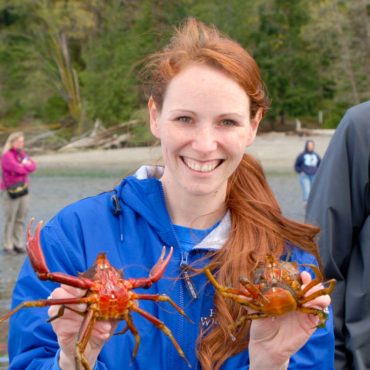 “This is an example of our commitment to serve kids and youth,” board member Jamie Algee said. “The whole tactile and interactive nature of the interpretive center is so admirable and it will definitely engage young people and open their minds to things they’ve probably never thought about.”
“This is an example of our commitment to serve kids and youth,” board member Jamie Algee said. “The whole tactile and interactive nature of the interpretive center is so admirable and it will definitely engage young people and open their minds to things they’ve probably never thought about.”
Brad Cheney, board president and executive director of the Cheney Foundation, said that the foundation supports a lot of small museums but this is the most innovative that that he has ever seen.
“It’s hands-on and interactive and I know that kids and adults will love it. I’m so glad that this is in Gig Harbor,” he said.
Admission to the interpretive center is free.
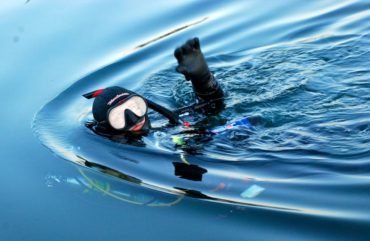
As interesting and interactive as the new indoor exhibits are, the majority of Harbor WildWatch’s programs take place outdoors and in local classrooms. Each program is designed to teach West Sound residents and students about the marine environment.
The Pier into the Night events, which take place monthly from October through March, are one of the organization’s most popular offerings, Easton said.
“Those happen at one of the nearby public piers. Divers swim around under the pier, shining underwater lights that attract all kinds of interesting sea creatures,” she said.
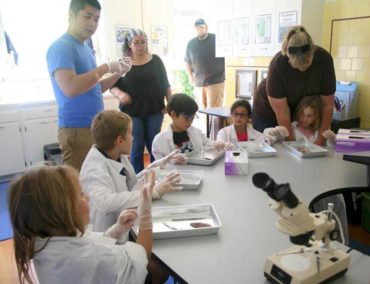
They also use video cameras to show close-ups of the underwater action.
Often, a few of the critters are carefully put into buckets that are hauled to a touch tank on the pier, where naturalists identify and describe them and sometimes let people touch them before they’re carefully released back into the water.
The pier peers only take place during the winter, Easton said, because summer evenings are too bright to get a good look at what’s swimming beneath the pier.
The March Pier into the Night — the last one for this season — had an attendance of 108 people who braved pouring rain and chilly temperature to see adult shiner perch, several types of sea stars, sea cucumbers, anemones and tube worms.
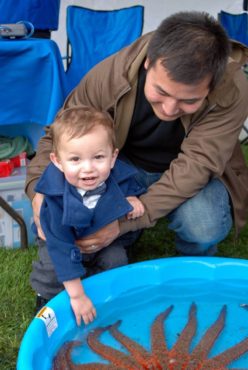
“The weather was absolutely awful but that didn’t stop anyone from having a great time,” Easton said.
Similar numbers of visitors attend WildWatch’s spring and summer “Get Your Feet Wet” beach walks.
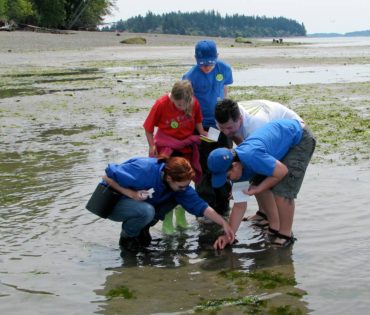
“We walk along the shoreline for an hour or so during low tide,” Easton said. “We talk about the different tidal zones and what lives there and how the sea life reacts when the tide changes. In the subtidal zone in the very low tides of summer, we see more soft-bodied, delicate creatures.”
Along the way, tour guides talk about proper beach etiquette.
“We use the word ‘GUEST’ to teach people about how to behave on a beach,” Easton said. “‘G’ is for ‘get your feet wet.’ Tread gently and if you touch something, do it gently with just one finger. Pet it, don’t poke it.
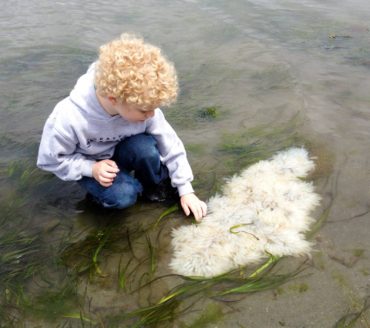
“‘U’ stands for ‘use your head.’ Don’t pick up a rock that’s any bigger than your head, because you might drop it and kill or injure some beach creature,” she said. “‘E’ reminds visitors to ‘leave everything where you find it,'” she said.
Finally, S stands for “step lightly and slowly” and “T” for “take your litter and all your belongings with you.”
“We’re visiting someone’s home when we’re on the beach and we need to be good guests,” Easton said.
Staff and volunteers also lead tours that focus on salmon, wetlands and even the history of Gig Harbor. All the tours are free.
During the school year, WildWatch staff works with local school districts to present programs that support and complement the science curriculum. In spring and fall, field courses introduce students to local beaches, wetlands and estuarine marine environments.
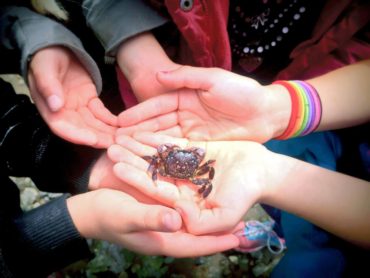
Outside the classroom, SeaStars, SunStars, Junior Naturalist and Teen Mentors programs teach young people about marine science and the importance of being good stewards of the environment. Students study local birds and mammals, whales, marine debris, salmon, ocean acidification, tides and tidal zones, geology, interpretive skills and other topics.
They also help with beach monitoring and walk in the annual Maritime Gig parade in early June. Scholarships are available for qualifying students.
For grown-ups, WildWatch’s Steward Club is an opportunity to learn about marine science and socialize, Easton said. One of the most popular membership benefits is the monthly Cocktails and Fish Tales “science socials.”
“Steward Club members get together at a local marina to hear speakers discuss local environmental issues and enjoy refreshments from local distilleries and breweries,” she said. “Our members really, really like these events.”
In all, in 2016, Harbor WildWatch presented more than 650 programs and reached more than 33,000 people in the West Sound area. The organization is on track to grow even more in 2017 as its works to live up to its motto, “Learn. Have fun.”




